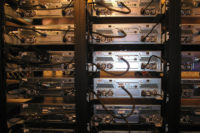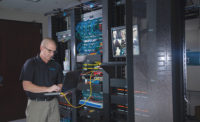3 Keys to Selling NVRs & DVRs
Experts share the top selling points (and one important consideration) for working with NVR and DVR solutions.

Finding DVR and NVR solutions that make installation and maintenance as easy as possible is critical to integrators’ profitability on every deployment. PHOTO COURTESY BCDVIDEO
With cloud-based recording continuing to gain acceptance and traction within the security industry, it can be easy to forget about the growth that’s occurring with the NVR — and even the elder statesman of recording, the DVR. That’s right, while NVRs have become more and more of the logical alternative to the cloud, DVRs do still have their place in the market. For more on that debate, see “The DVR is Dead. Long Live the DVR?”
When working with NVRs and to a lesser extent DVRs, there are three key features integrators can highlight and use to gain customer buy-in and close more sales: non-security application, cybersecurity and overall flexibility. Ease of installation must be a fourth factor, as complex or complicated deployments can quickly eat away at integrators’ profits.
BEYOND SECURITY
End users today have been conditioned to look for more from their surveillance systems, which means looking at solutions that offer the ability to address needs that fall outside traditional security applications.
“They live in a world of connected devices that do some or all of the thinking for them,” says Troy Wideman, regional marketing manager, Bosch Security Systems, Fairport, N.Y. “Why can’t they get that from their commercial systems? For example, customers are now looking for analytics to aid retailers with better capabilities to manage queues at checkouts, mapping where customers spend their time in the store, and how many people were in the store on any given day.”
Jeff Burgess, CEO, BCDVideo, Northbrook, Ill., adds, “Today’s NVR is a robust system solution with the ability to expand beyond merely recording the video, but also have the capability to manage the analytics, facial recognition, and other video technologies.”
When selling DVRs and NVRs, integrators have to think outside the box (pun intended) to find ways to address end users’ pain points on many fronts that extend beyond security.
“Integrated solutions are critical, as it is important for the video to be used not just for security, but also for obtaining information to help create a system that can meet the needs of customers from all aspects,” Wideman says. “Finding ways to utilize the stored video for more than just security events will also help to increase the role that these devices play in a complete system and the value they provide to the end user.”
With this in mind, Digital Watchdog, based in Cerritas, Calif., is making it easier for end users to incorporate a wider variety of technologies and systems into a single solution.
“The new feature we’re about to provide is adding an IoT hub to our DVRs to make a unified security solution — control your door locks, sensors, lights and appliances and get visual confirmation all within the same app,” says Mark Espenschied, the company’s director of marketing.
CYBERSECURITY
In every aspect of life, network security has become an increasing consideration and concern. Video surveillance is no exception to the rule that it is vital to ensure the security of connections into and out of the network is as robust as possible.
“The NVR may represent a hole on the network; it might not be as secure as the rest of the systems,” says Francis Lachance, director of product management, Genetec, Montreal. “A network is only as secure as its weakest point. So you may have a super secure network, but if one little piece is not secure, that puts the entire network at risk.”
Therefore strong logical security is a key component in evaluating any recording solution.
“Cybersecurity should be an expectation, as it should with anything attached to the network; and integrators have to do everything possible to avoid the NVR being the weakest link in the security ecosystem, including multi-factor authorization, for example,” Burgess says.
The need for cybersecurity is especially vital because of the potential for a single location to introduce vulnerabilities to others via compromised video that is sent upstream.
SCALABILITY
Adaptability is a primary advantage NVRs offer over DVRs, which require an analog cable to connect to each camera, Wideman says.
“Customers like NVRs because of this scalability,” he says. “It allows them to grow their security solutions without the need to replace the pieces. Storage is scalable so that you can have as much or as little as you desire.
For many users, recorders that offer the ability to deploy multiple types of cameras offer the best of both — or many — worlds.
“Hybrid, tri-brid and/or pentra-brid DVRs allow increased flexibility in adding newer, higher resolution cameras to existing one,” says Steve Wilbur, training manager, Dahua Technology USA, Irvine, Calif. “These DVRs can be compatible across a broad range of camera formats, allowing a wide choice of cameras and technology.”
EASE OF INSTALLATION
Before, during and after the sale, integrators must also be mindful of how easy or difficult a solution will be to deploy and configure. And while IP solutions are becoming more mainstream, they can also be more difficult to install and deploy than analog, Wideman says.
“Any feature in an NVR that can allow cameras to be discovered, configured, and viewed easily will be features that will make integrators’ lives better,” he says.
To that end, Burgess recommends selecting a self-contained, preconfigured solution.
“The integrator already has a full plate. The last thing they need to do is mess around with the box when they get it,” he says. “The NVR as an appliance should deliver with the proper licenses pre-loaded, and the system parameters set to record based up on the site’s needs. The NVR should offer the same disaster recovery and site restoration features as enterprise video recording servers possess. A system recording eight cameras is just as important as a system recording 500 of them. At least it should be built that way.”
For integrators, Wideman says, the two most common issues with NVRs are IP addressing and connecting cameras to the NVRs, adding that training in these areas is vital and will go a long way toward streamlining installations.
“IP cameras bring with them a long list of additional features that can be taken advantage of, but there is a need to understand them first,” he says. “It is also important for them to know how items, such as simple motion detection, work on IP cameras. Many times they are trying to have the camera detect motion in an area 300 feet away and can’t understand why the camera can’t sense that. So, understanding IP addressing and camera settings will aid them.”
To ease post-installation, Wilbur suggests integrators look for solutions — both DVRs and NVRs — that offer features that will also make ongoing maintenance easier for integrators.
“Most DVRs have a multitude of self-monitoring features that can alert the installer or end user if the system isn’t operating as intended. This can include running out of HDD space, imminent HDD malfunction or network down,” he says.
For many integrators, however, these considerations may actually be a moot point, says Nick Montes, marketing communications specialist, LTS, City of Industry, Calif.
“Integrators have their own IT team or groups that usually can handle it. Plug-and-play helps save time, but integrator level is already senior,” he says.
All the advice in the world means nothing if integrators fail to remember the main purpose of the system and make sure the solution is built for that. This, says Ramy Ayad, senior product manager, Hanwha Techwin America, Ridgefield Park, N.J., may be the most vital consideration.
“The system is made for surveillance purposes, so all functions and features that have to be set are related only to this surveillance part, so the installer doesn’t have to deal with a more generic operating system that requires firewall, antiviruses, locking down, and so on,” he says. n
Similar or Different?
There are two schools of thought with regard to the relationship between DVRs and NVRs. Some, like BCDVideo’s Jeff Burgess, feel that the evolution of the two is drawing them ever closer to being more similar than different. “I’m not sure there is much of a difference between the two anymore, what with the NVR’s capability to record both analog and digital cameras,” he says. “Perhaps the true benefit of the DVR these days is not being on the network, thus free from ‘hackability,’ but new cyber advances in NVRs are eliminating that as well.”
On the other hand, Troy Wideman of Bosch Security is one of those who feel the two are and will remain very distinct because of significant differences. “It’s important to understand that these terms are not interchangeable. DVRs specifically refer to analog video connections to the recorder and NVRs specifically refer to IP connections to the recorder,” he says. “When the two exist on the same device, it is a hybrid recorder. It is often these hybrid devices that allow a company, which still has some analog channels, to convert to an IP solution at their own pace.”
Words of Wisdom
SDM asked each of the industry insiders interviewed for this story to provide at least one piece of advice about working with DVRs and NVRs that installers and integrators would find helpful. Below are their responses:
Ramy Ayad, Hanwha Techwin USA: “Using NVRs and DVRs is simple; but if it is expected to work hand in hand with access control system, for example, depending on the level of integration required it might not be easy or possible. Understand the customer’s requirement and research the integration level between each component of the system.”
Jeff Burgess, BCDVideo: “Don’t settle because of price. Although $200 may equate to 10 percent savings on the system price, how much downtime will it take to negate those savings? Purchase a quality system with proven components that will support the site for at least five years. Look for internal technologies that could cut your support costs over the duration of the project.”
Mark Espenschied, Digital Watchdog: “Don’t be afraid to move to a server and VMS when the number of cameras justifies an enterprise management solution (rather than stacking DVR or NVR boxes).”
Francis Lachance, Genetec: “The rule for connected systems is to make sure you have updated systems, which requires that you update software and firmware to the latest version with the latest security patches.”
Nick Montes, LTS: “The most common suggestion we tell our installers and integrators is to provide a proper separate network management, bandwidth, and traffic management solution such as VLAN, VPN, etc.”
Troy Wideman, Bosch Security: “Two of the most common issues with NVRs deal with IP addressing and camera configuration. It is extremely important that integrators properly train their staff on IP addressing and how the cameras connect to the NVR. IP cameras bring with them a long list of additional features that can be taken advantage of, but there is a need to understand them first. It is also important for them to know how items, such as simple motion detection, work on IP cameras.”
Steve Wilbur, Dahua Technology USA: “For analog retrofit applications using existing cable, verify the length and type of cable. Verify that the new camera and new DVR will work over those cables at those distances. For existing and new systems, verify third-party cameras are compatible with the recorder you are intending to use. When matching IP cameras to a recorder (NVR or hybrid DVR), pay attention to the recorder’s ‘maximum incoming bandwidth spec.’”
The DVR Is Dead, Long Live the DVR?
There is no question in anyone’s mind that IP-based technology, particularly in the video space, has not only overtaken but is also rapidly outpacing those analog solutions in terms of market share. Many in the industry predict that sales of new analog technologies will soon dry up altogether.
“DVRs are dead,” says Genetec’s Francis Lachance. “If you’re talking about recording analog cameras, there are tons of DVRs installed but moving forward, the number of analog cameras sold is minimal compared to IP. Practically no more analog cameras are being sold for new installations.”
According to Bosch Security’s Troy Wideman, research firmly supports this view.
“DVR market share in North America is predicted to be around 25 percent by 2018. However, moving forward as more of the analog-based wiring is replaced by IP capable systems, this number will continue to decline,” he says.
However, this view is hardly universal among the industry, as there are others who channel their inner Mark Twain to argue that reports of DVRs’ death have been greatly exaggerated — and there is research to support this claim as well, says Digital Watchdog’s Mark Espenschied.
“Many people assume that IP is the fastest growing market in video surveillance, but IHS research revealed that HD Analog is the fastest growing market in video surveillance globally,” he says.
The reason has everything to do with the installed base of legacy infrastructures.
“There are billions of dollars of coax already installed,” Espenschied says. “The ability to swap out HD DVRs and HD cameras, as well as continue to manage legacy cameras, has been a game changer. HD Analog resolutions will increase and the ability to manage those resolutions at fast frame rates will be developed.”
Even Wideman admits that while the end of the DVR area may be coming, it likely won’t be anytime soon, although their form factor and how they are deployed are likely to change in the very near future.
“(DVRs) are still relevant today in many locations. Supporting analog cameras is a required precursor for customers unable to afford the cost of a rip and replace upgrade,” he says. “Therefore, a combination NVR/DVR is a must-have in the product portfolio. This allows end users to continue to use analog solutions until they have fully made the switch to IP capable systems.”
In short, the existing market is still too large to discount.
“The ability to record both analog and digital cameras continues to be a necessity,” says Jeff Burgess of BCDVideo. “There is still a large population of analog cameras, so their continued expected usage cannot be ignored.”
As for specific markets that are still ideal for DVRs, those where cost is a significant — if not primary — concern are where the opportunities lie.
“DVRs are still significant in the small to mid-size project markets due to liability and quality of the embedded system product, as there are minimum maintenance needed, and no IT department required to maintain the system, which is on its own a huge cost saving from the customer perspective,” says Ramy Ayad of Hanwha Techwin America.
So while the perception may be that the impending death of the DVR is settled science, the best advice would be not to discount analog altogether. At least not now — if ever.
MORE ONLINE
For more on NVRs and DVRs visit SDM’s website, where you will find the following articles:
“Keys to Meeting End Users’ Video Storage Needs”
“6 Trends Driving Recording Technologies”
“Why HDoC is a Compelling Alternative”
Looking for a reprint of this article?
From high-res PDFs to custom plaques, order your copy today!








